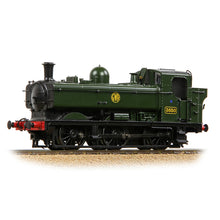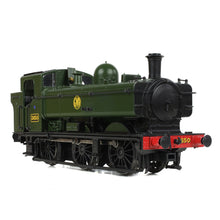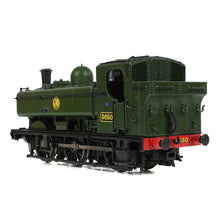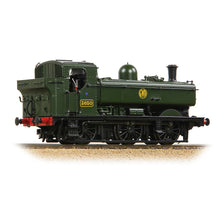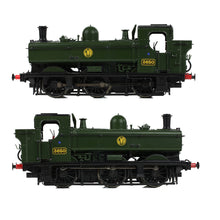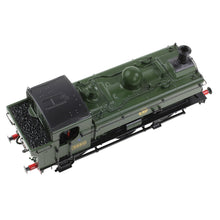
GWR 8750 Pannier Tank 3650 GWR Green (Shirtbutton)
32-198
Bachmann
Branchline
Era - Era 3
Running Number - 3650
Additional Info 1 - N/A
Additional Info 2 - N/A
Accessories - No
Motor Type - 3 Pole
DCC - 8 Pin Socket
Speaker? - No
DCC Fans - N/A
Tinted Windscreen Glazing? - N/A
Auto-Release Couplings? - No
Bach-Up Stay Alive? - No
Firebox Lighting - No
Directional Lighting - N/A
Cab Lighting - N/A
Interior Lighting - N/A
Weathered - No
Preserved - Yes
Passengers Fitted? - N/A
Supplied with Load - N/A
Supplied with Etched Plates? - N/A
Length (over couplings) - 130mm
NEM Couplings - Yes
Sprung Buffers - Yes
Tender Pickups - N/A
Adjustable Tender Drawbar - N/A
-
-
The Pannier Tank ; is undoubtedly one of the most iconic tank locomotives to have operated in Great Britain, with the real locomotives being built by the Great Western Railway (GWR) over a period of more than fifty years and to evolving designs. The Class 8750 Pannier Tank was part of the 57XX family, the most numerous of any Pannier built by the GWR, and now you too can enjoy OO Scale models of this Western stalwart thanks to the Bachmann Branchline range.
Humble yet unmistakable, the Branchline model carries all the hallmarks of the GWR Class 8750 Pannier Tank and offers high performance to match. Employing a high fidelity bodyshell which is injection moulded complete with rivet and panel detailing, numerous components are then added separately to capture many aspects of the prototype in full relief, from the tank fillers to the safety valves, whistles and whistle guard. Metal handrails are then added, fitting into individual metal handrail knobs where appropriate, and the model also sports sprung metal buffers at each end along with fine metal took rests mounted to the rear of the bunker.
The chassis, powered by a substantial 3 pole motor, carries an 8 pin DCC decoder socket and is adorned with details like the springs, brake blocks, brake rigging and sand boxes accompanied by separate wire sandpipes. NEM couplings pockets can be found at the front and rear, allowing the tension lock couplings supplied with the model to be easily removed and exchanged for an alternative system. The livery is applied to the usual high standard you would expect from a Bachmann model, with rich paintwork adorned with finely printed lettering and numbering to produce a model that is fit for those modelling in GWR days, or the preservation scene.
MODEL FEATURES:
CLASS 8750 HISTORY
The Class 8750 Pannier Tank was a derivative of the Great Western Railway (GWR) Class 57XX design, the company most prolific class of locomotive. The 57XX was first introduced in 1929 and construction continued for 21 years until the final examples were outshopped by British Railways. Such was the success of the design that it became the GWR standard shunting and general purpose tank engine, used for shunting, light goods traffic and even passenger workings on branch lines and suburban routes.
The first three hundred locomotives to be built were classified as 57XXs (or 67XXs depending on their braking systems) but from 1933 a new, larger cab was introduced which incorporated square windows instead of round, and provided more enclosed side sheets for better crew comfort. Locomotives built from 1933 with this new cab were designated Class 8750s and when the 863rd and final Pannier Tank belonging to the 57XX family rolled off the production line, the Class 8750s made up the majority of the fleet.
Employed across the GWR network and then the Western Region following Nationalisation, all 863 locomotives passed into British Railways ownership before the first 8750 was withdrawn in 1957. The type would remain in service for another decade, with withdrawals accelerating at the start of the 1960s before British Railways withdrew the final examples in 1966. Even then, some of these Pannier Tanks were still in use with London Transport (LT) and other private operators who had purchased them from BR; the LT Panniers surviving in traffic until 1971. Ultimately, sixteen Pannier Tanks from the 57XX family survive today in preservation, half of which are genuine 57XXs whilst the other half are Class 8750s.
Expected delivery Winter 2024 subject to availability
32-198
Bachmann
Branchline
Era - Era 3
Running Number - 3650
Additional Info 1 - N/A
Additional Info 2 - N/A
Accessories - No
Motor Type - 3 Pole
DCC - 8 Pin Socket
Speaker? - No
DCC Fans - N/A
Tinted Windscreen Glazing? - N/A
Auto-Release Couplings? - No
Bach-Up Stay Alive? - No
Firebox Lighting - No
Directional Lighting - N/A
Cab Lighting - N/A
Interior Lighting - N/A
Weathered - No
Preserved - Yes
Passengers Fitted? - N/A
Supplied with Load - N/A
Supplied with Etched Plates? - N/A
Length (over couplings) - 130mm
NEM Couplings - Yes
Sprung Buffers - Yes
Tender Pickups - N/A
Adjustable Tender Drawbar - N/A
-
-
The Pannier Tank ; is undoubtedly one of the most iconic tank locomotives to have operated in Great Britain, with the real locomotives being built by the Great Western Railway (GWR) over a period of more than fifty years and to evolving designs. The Class 8750 Pannier Tank was part of the 57XX family, the most numerous of any Pannier built by the GWR, and now you too can enjoy OO Scale models of this Western stalwart thanks to the Bachmann Branchline range.
Humble yet unmistakable, the Branchline model carries all the hallmarks of the GWR Class 8750 Pannier Tank and offers high performance to match. Employing a high fidelity bodyshell which is injection moulded complete with rivet and panel detailing, numerous components are then added separately to capture many aspects of the prototype in full relief, from the tank fillers to the safety valves, whistles and whistle guard. Metal handrails are then added, fitting into individual metal handrail knobs where appropriate, and the model also sports sprung metal buffers at each end along with fine metal took rests mounted to the rear of the bunker.
The chassis, powered by a substantial 3 pole motor, carries an 8 pin DCC decoder socket and is adorned with details like the springs, brake blocks, brake rigging and sand boxes accompanied by separate wire sandpipes. NEM couplings pockets can be found at the front and rear, allowing the tension lock couplings supplied with the model to be easily removed and exchanged for an alternative system. The livery is applied to the usual high standard you would expect from a Bachmann model, with rich paintwork adorned with finely printed lettering and numbering to produce a model that is fit for those modelling in GWR days, or the preservation scene.
MODEL FEATURES:
- Bachmann Branchline OO Scale
- Era 3
- Locomotive is Preserved
- Pristine GWR Green Shirtbutton ; livery
- Running No. 3650
- Water Fillet Caps with Clasp Closure
- NEM Coupling Pockets
- Sprung Buffers
- Powerful 3 Pole Motor
- Equipped with a 8 Pin DCC Decoder Socket Recommend Decoder item No. 36-566A
- Length 130mm (over couplings)
CLASS 8750 HISTORY
The Class 8750 Pannier Tank was a derivative of the Great Western Railway (GWR) Class 57XX design, the company most prolific class of locomotive. The 57XX was first introduced in 1929 and construction continued for 21 years until the final examples were outshopped by British Railways. Such was the success of the design that it became the GWR standard shunting and general purpose tank engine, used for shunting, light goods traffic and even passenger workings on branch lines and suburban routes.
The first three hundred locomotives to be built were classified as 57XXs (or 67XXs depending on their braking systems) but from 1933 a new, larger cab was introduced which incorporated square windows instead of round, and provided more enclosed side sheets for better crew comfort. Locomotives built from 1933 with this new cab were designated Class 8750s and when the 863rd and final Pannier Tank belonging to the 57XX family rolled off the production line, the Class 8750s made up the majority of the fleet.
Employed across the GWR network and then the Western Region following Nationalisation, all 863 locomotives passed into British Railways ownership before the first 8750 was withdrawn in 1957. The type would remain in service for another decade, with withdrawals accelerating at the start of the 1960s before British Railways withdrew the final examples in 1966. Even then, some of these Pannier Tanks were still in use with London Transport (LT) and other private operators who had purchased them from BR; the LT Panniers surviving in traffic until 1971. Ultimately, sixteen Pannier Tanks from the 57XX family survive today in preservation, half of which are genuine 57XXs whilst the other half are Class 8750s.
Expected delivery Winter 2024 subject to availability






